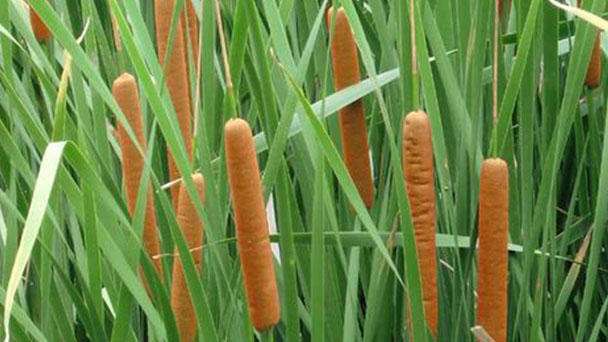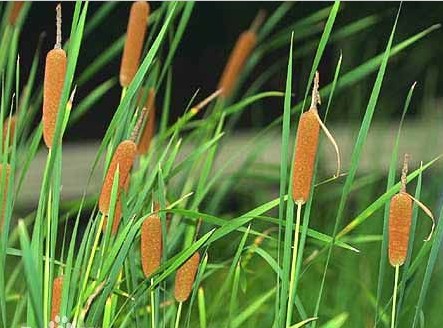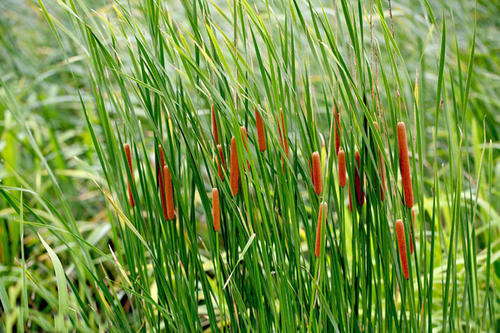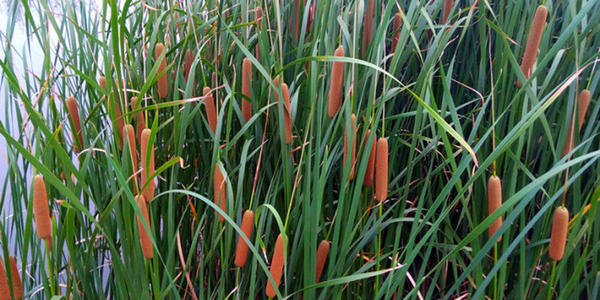Bulrush profile
Written by Maggie
Dec 22 2020

Typha orientalis, commonly known as bulrush or cumbungi, is a perennial herbaceous plant in the genus Typha. It is native to Australia, New Zealand, Malaysia, Indonesia, Japan, Korea, Mongolia, Myanmar, Philippines, China and the Russian Far East.
Bulrush picture

Morphological characteristics of Bulrush
Bulrush is a perennial aquatic or marsh herb. The rhizome is milky white. The stem is stout, tapering upward, 1.3-2 m high. The leaf blade is oblong, 40-70 cm long and 0.4-0.9 cm wide, smooth and glabrous, flat on the upper part, slightly concave on the lower ventral surface, convex on the back gradually, semicircular in cross section, large intercellular space and spongy. The laf sheath clasps the stem.
Male and female inflorescences are closely connected; Male inflorescences are 2.7-9.2 cm long, inflorescence shafts with white curved pilose, 1-3 leaflike bracts ascending from base, glabrous; Female inflorescences are 4.5 -- 15.2 cm long, base with 1 leaflike bract, glabrous; Male flowers are usually consist of 3 stamens, sometimes 2, or 4 stamens united, anthers ca. 3 mm, 2-loculed, striate, pollen grains monomer, filaments very short, base connate into short stalks; Female flowers are without bracteoles; Bulrush gestational female stigmata is spatulate, out curved, ca. 0.5 -- 0.8 mm long, style 1.2 -- 2 mm long, ovary spindle to lanceolate, ovary stipitate, ca. 2.5 mm long; Infertile female flower ovary ca. is 1.2 mm, nearly conical, apex rounded, stigma absent; White filamentous hairs are usually solitary, sometimes several basally connate, slightly longer than style, shorter than stigma.
Bulrush nutlets are elliptic to elongate elliptic; The pericarp is with long brown spots. Bulrush seeds are brown, slightly curved. Flowering and period is from May to August.
Bulrush Habitat and origin
Bulrush is found in lakes, ponds, ditches, swamps and river slow-flow zones. It is cultivated in Heilongjiang, Jilin, Liaoning, Inner Mongolia, Hebei, Shanxi, Henan, Shaanxi, Anhui, Jiangsu, Zhejiang, Jiangxi, Guangdong, Yunnan, Taiwan and other provinces in China. Philippines, Japan, the former Soviet Union and Oceania and other places are distributed.
Bulrush growth habit
Bulrush likes high temperature and a wet climate, and the suitable temperature for growth is 15-30℃. When the temperature drops below 10℃, the growth basically stops. During the overwintering period, the plant can withstand low temperatures of -9 ℃. It is suitable for 20-60 cm depth and can withstand 70-80 cm deep water. In The Yangtze River basin, mosses are plucked and blossomed in June and July. The soil requirements are not strict. It can grow on both clay and sandy loam, but it is better to use the loam with organic matter of more than 2% and a deep silt layer.

Bulrush propagation technique
Bulrush has a robust growth and a simple propagation method. In production, Bulrush usually adopts the method of plant division or sowing.
Individual plant propagation: from April to June. Dig out the rhizomes under the cattail, cut them into new plants with 6-7 buds in each cluster with sharp knives, and transplant them separately.
Sowing propagation: carried out more than in spring. Do not cover soil after sowing, pay attention to keep the bed wet, summer seedlings after forming before cutting.
Bulrush main value
Nutrition
The tender stems and leaves of Bulrush can be eaten as a vegetable.
Ecological
In the garden application of Bulrush, its protection of the ecological function of the wetland system is also an important aspect. Due to its developed root system, The combination of Bulrush and scallion is conducive to the purification of water quality. In addition, Bulrush can also control soil erosion, promote soil development and maturation, increase the content of organic matter and N, P and K in the soil, and thus improve soil fertility. As more and more attention is paid to the protection and development of wetlands, Bulrush is widely used in urban wetland parks around the world with its wild aquatic plants, which can not only achieve good ecological protection effect for each city, but also provide habitat for other creatures and enrich the biodiversity of the whole wetland park.
With the continuous development of the economy, environmental pollution is becoming more and more serious, among which industrial and mining wastewater is one of the sources of environmental pollution. Because Bulrush is able to tolerate high concentration of heavy metals and has strong adaptability, fast growth and enrichment ability, it has attracted much attention and attention and has been widely applied in the treatment of industrial and mining wastewater pollution environments. Bulrush plants can also effectively purify pollutants such as phosphorus, nitrogen, CODcr, BODS and total suspended matter in urban domestic sewage and industrial and mining wastewater.
Greening
Bulrush is often used to decorate garden pools and lakes to build waterscapes, which should be used as background materials for flower borders and waterscapes. It can also be potted to decorate the garden. Because Bulrush generally grows in clusters and patches in moist and watery environments, plant background materials are usually used in water landscape design. Bulrush and other aquatic plants are designed in accordance with their ornamental and ecological functions to create a beautiful natural aquatic community landscape. In addition, Bulrush and other wild aquatic plants can also be used in simulating the nature of streams, fountains, falls, waterfalls and other garden waterscape, making the landscape wild and colorful with unique flavor.

Medicinal
Bulrush pollen is called Puhuang in Chinese traditional medicine. Puhuang has a long history of application in China, and has the functions of promoting blood circulation, eliminating stasis, stopping bleeding and relieving pain, and regulating drenching. Literature reports, cattail pollen has analgesic, anticoagulant coagulant, promote blood circulation, reduce blood fat, prevent arteriosclerosis, protect hyperlipidemia caused by vascular endothelial injury, excitation contraction of uterus, enhance immunity, and so on, and promote intestinal peristalsis, anti-inflammatory, resistance to low oxygen, antimicrobial and other pharmacological effects, which has been widely used in clinical.
Economic
Bulrush hand-woven fabrics such as straw bags, bales, mats, cushions, tea mats and baskets made from leaves with high fiber content are exported to foreign countries, which can produce better economic benefits. Bulrush whole grass is a good raw material for papermaking, containing 35%-60% fiber and producing hemp rate above 38.3%. The leaves and leaf sheaths can be processed into artificial cotton by alkali boiling. Fresh grass collected in September contains 81.78% of water, 3.16% of crude protein and 4.06% of crude fiber. Dry whole Bulrush water 10.20% hemicellulose 16.6% cellulose 56.2%. The degummed fibers can be woven into sacks and rolled rope, and their tensile force and quality are both higher than that of straw rope. The ripe female flowers are called cattails and may be dipped in oil or not for illumination. The hair on the female floral sequence is called lint, which is almost pure fiber and is often used as pillow catkin.
Latest Updated
- Benefits of Bugleweed - 7 Science-backed Health Benefits
- Bugleweed Dangers & Side Effects - Is It Poisonous?
- How to Plant Evergreen Trees - What You Should Know
- When to Plant Evergreens - Grow Guide for Evergreen Trees
- 12 Wonderful Evergreen Shrubs for Your Garden
- 12 Popular Evergreen Plants with Pictures for Beginners
- When And How To Prune A Lilac Bush Like a Pro
- How to Grow & Care for Lilac Vine (Hardenbergia Violacea)
- Japanese Lilac Tree (Syringa Reticulata) Care & Propagation Guide
- Shumard Oak Pros and Cons - What to Know
Popular Articles
- Winter maintenance of Antirrhinum Majus
- How to Grow Terminalia Mantaly Tree
- How to Grow and Care for Crossostephium Chinense
- How to grow Antirrhinum Majus in spring
- Peristeria Elata (Dove Orchid) Profile: Info & Care Guide
- Underwatered Snake Plant (Sansevieria Trifasciata) - Signs And How To Fix
- How to Care for Brazilian Jasmine Plant (Mandevilla Sanderi)
- How to Grow & Care for Graptopetalum Purple Delight in Summer
- Rosa Chinensis (China Rose): Plant Growing & Care Tips
- How to Care for Baby Sun Rose (Aptenia Cordifolia)